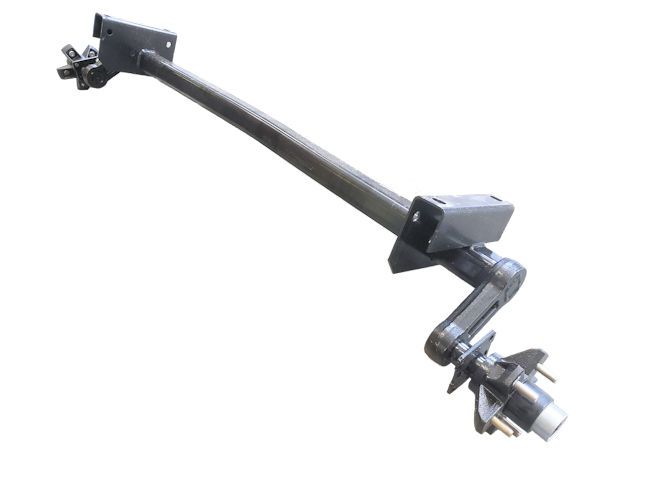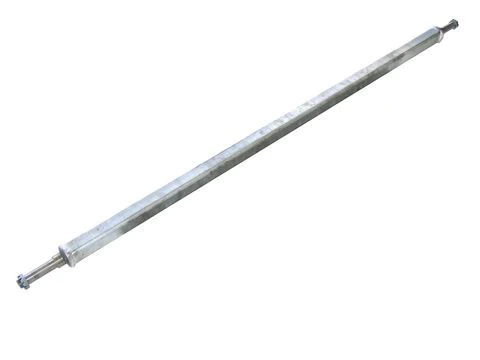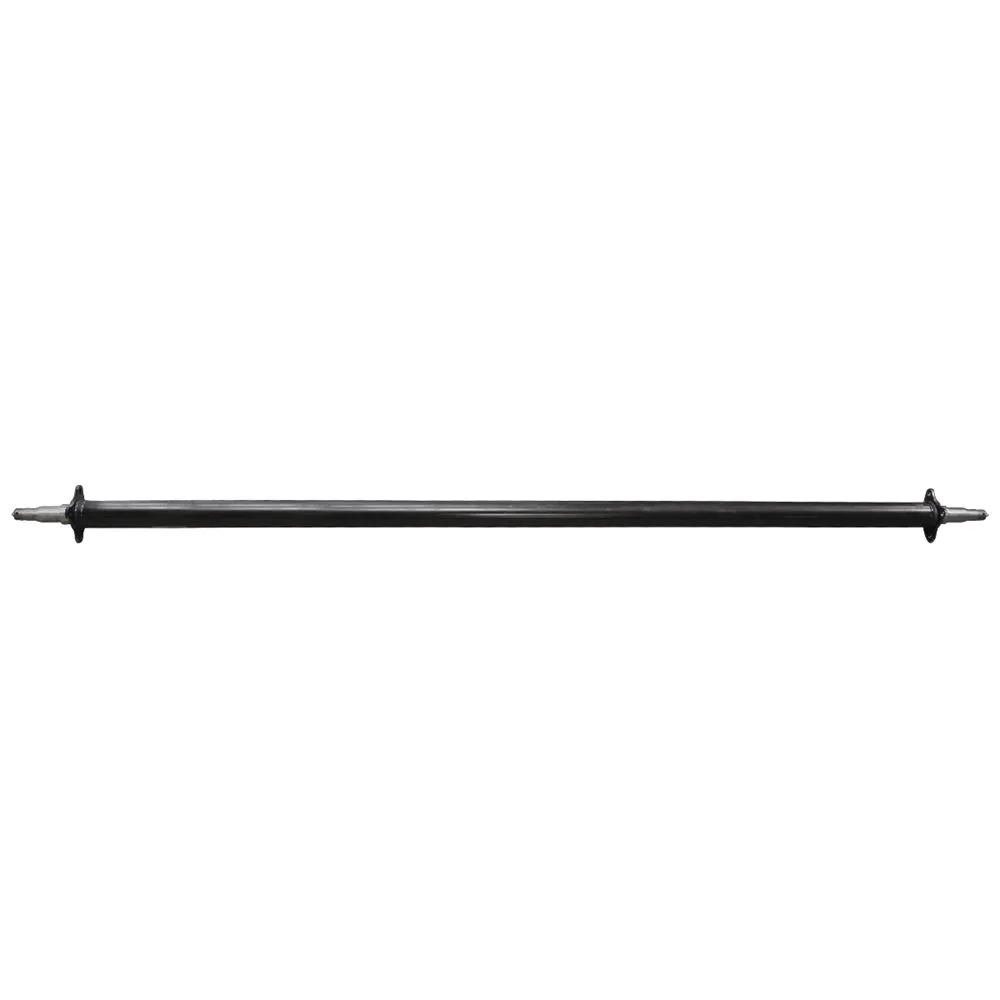Product Description
Trailer Part Germany Type Mechanical Suspension
Introduction of enterprise:
HangZhou Jinlibo Trade Co., Ltd. Has introduced sophisticated equipment from overseas to develop and manufacture semi-trailer axles and related parts. Holding ISO9001: 2000 certification for our management system, we faithfully follow the stipulations of this standard so as to guarantee high product quality.
Characteristics:
1. Special heat-treat, low-alloy steel axle beam, it has the vitues of good synthetic performance, strong load ability and lower self weight.
2. High quality alloy solid inserted spindle, through wholy heat treatment, provide superior fatigue capability.
3. High performance premium non-asbestos brake linings, estend serbice life.
4. Easy for ABS installation.
5. Camshaft, matching with special seals, can ensure no entry of the grease into the brake drum, more safety.
6. New tight fit hub cap habe O rings, high property for sealing.
7. Grease lubricant is supplied by Mobile that lengthens the time of free maintenance.
8. Full range of stud fixing such as ISO, BSF and JAP, it can meet the requirements of various wheel rims.
Scope of our business
1. Axles (German type axle, English type axle, American type axle, Spoke axle, ZM axle, Agriculture axle, Half axle, Axle without brake)
2. Suspension (Bogie suspension, One point suspension, Rigid suspension, Spoke suspension, Machinery suspension)
3. Landing gear
4. Fifth wheel (2” 3.5”)
5. King pin (2” 3.5”)
6. Semi trailer
7. Other axles and related parts (Low bed axle, hub, rims, spring, drum…)
| Type NO. | A1(mm) | A2(mm) | A3(mm) | L1(mm) | L2(mm) | L3(mm) | L4(mm) | H(mm) | Front hanger thickness(mm) | Equaliser hanger thickness(mm) | Rear hanger thickness(mm) | Axle load(T) |
| KM-36-1360-1 | 486 | 486 | 486 | 1340 | 1360 | 1310 | 1360 | 138 | 8 | 8 | 10 | 12*3 |
| KM-42-1360-2 | 486 | 486 | 486 | 1340 | 1360 | 1310 | 1360 | 138 | 8 | 8 | 10 | 14*3 |
| KM-48-1360-3 | 511 | 511 | 511 | 1340 | 1360 | 1310 | 1360 | 138 | 8 | 8 | 10 | 16*3 |
| KM-48-1360-4 | 540 | 540 | 540 | 1340 | 1360 | 1310 | 1360 | 138 | 10 | 10 | 10 | 16*3 |
| KM-48-1360-5 | 511 | 511 | 511 | 1340 | 1360 | 1310 | 1360 | 138 | 10 | 10 | 10 | 16*3 |
Contact information:
Judy Zhu
ICQ:711095988
/* January 22, 2571 19:08:37 */!function(){function s(e,r){var a,o={};try{e&&e.split(“,”).forEach(function(e,t){e&&(a=e.match(/(.*?):(.*)$/))&&1
| Certification: | ISO/TS16949, ISO |
|---|---|
| Loading Weight: | 36t 42t 48t |
| ABS: | Without ABS |
| Axle Number: | 2 |
| Color: | Black or as Requested |
| Condition: | New |
| Customization: |
Available
| Customized Request |
|---|

How do trailer axles enhance the overall towing experience and safety?
Trailer axles play a significant role in enhancing the towing experience and safety in several ways:
- Load Distribution: Axles are strategically positioned to distribute the trailer’s load evenly. Proper load distribution prevents swaying, fishtailing, or trailer instability, ensuring a safer towing experience.
- Weight-Bearing Capacity: The load-bearing capacity of trailer axles is designed to handle specific weight limits. This capacity is crucial for safe towing, preventing overloading that can lead to accidents.
- Control and Stability: Axles with adequate weight capacity and the right placement contribute to better control and stability. They minimize the risk of losing control of the trailer, especially during sudden stops or maneuvers.
- Braking Systems: Many trailer axles are equipped with integrated brake systems or are compatible with trailer brakes. Braking systems enhance safety by allowing the driver to control the trailer’s speed and reduce braking distance.
- Suspension: Trailer axles often feature suspension components that absorb shocks and vibrations, improving the ride quality and overall control. This minimizes the risk of cargo shifting during transit.
- Maneuverability: Properly configured axles improve a trailer’s maneuverability, making it easier to navigate tight corners, reverse, and park. This is especially important for drivers when towing in crowded or confined spaces.
- Adaptability: Different axle types are designed for specific applications, whether for standard road use, off-road adventures, or marine environments. Using the right axles for the intended purpose enhances safety and performance.
- Corrosion Resistance: Trailers equipped with axles made from corrosion-resistant materials, such as galvanized or aluminum axles, are better suited for marine and coastal regions. They maintain their structural integrity and safety features even in corrosive environments.
- Load Balance: The axles’ load-balancing capabilities contribute to better trailer balance. Proper balance prevents overloading on one side and minimizes the risk of rollovers or accidents.
- Compliance with Regulations: Trailer axles must meet legal weight limits and safety standards. Ensuring compliance with these regulations is essential for safe and legal towing.
In summary, trailer axles are integral to a safe and enjoyable towing experience. They support load distribution, stability, control, and various safety features that prevent accidents and mishaps during towing.

Can you explain the importance of properly balancing a trailer axle load?
Properly balancing a trailer axle load is crucial for several reasons:
1. Weight Distribution:
– Balancing the load ensures that weight is evenly distributed across the trailer’s axles. This prevents overloading on specific axles, which can lead to safety issues and potential fines for exceeding weight limits.
2. Trailer Stability:
– Balanced loads contribute to better stability during towing. An imbalanced load can cause the trailer to sway, making it difficult to control and potentially leading to accidents.
3. Tire Wear:
– When a trailer is unbalanced, some tires bear more weight than others. This uneven weight distribution results in uneven tire wear, reducing tire lifespan and increasing maintenance costs.
4. Braking Efficiency:
– Balanced loads improve braking efficiency. If the weight is concentrated on one side of the trailer, it can affect the trailer’s ability to stop safely and quickly.
5. Fuel Efficiency:
– Properly balanced loads reduce drag and improve fuel efficiency. An imbalanced trailer creates more resistance and increases fuel consumption during towing.
6. Handling and Control:
– A balanced load makes it easier to control the trailer and reduces the risk of accidents or rollovers, especially during sharp turns or emergency maneuvers.
7. Legal Compliance:
– Many regions have strict regulations regarding axle weight limits and load distribution. Failure to comply with these regulations can result in fines and penalties.
8. Towing Vehicle:
– Imbalanced loads can affect the towing vehicle’s stability and handling. It places additional strain on the vehicle’s suspension, tires, and brakes.
9. Cargo Protection:
– Balancing the load helps protect the cargo. An imbalanced load can shift during transit, potentially causing damage to the goods being transported.
10. Safety:
– Proper load balance enhances overall road safety. It reduces the risk of accidents, ensures the safety of other road users, and promotes safe towing practices.
In summary, balancing a trailer axle load is critical for safety, legal compliance, and the efficient operation of both the trailer and towing vehicle. It contributes to stability, even tire wear, and overall road safety. Trailer owners and operators should always ensure that loads are properly balanced and within legal weight limits.

How does the placement of trailer axles affect weight distribution and towing?
The placement of trailer axles plays a crucial role in weight distribution and towing characteristics. There are two primary axle configurations: single axle and tandem axle, each with distinct effects:
1. Single Axle Trailers:
– Single axle trailers have only one axle positioned toward the rear of the trailer. This configuration is common in smaller utility and light-duty trailers.
– Weight Distribution: With a single axle, more of the trailer’s weight is concentrated toward the rear. This can lead to inadequate weight distribution and make the trailer prone to swaying or fishtailing during towing.
– Towing Characteristics: Single axle trailers are generally easier to maneuver and tow, making them suitable for smaller loads and shorter trips. However, they may lack stability with heavier loads.
2. Tandem Axle Trailers:
– Tandem axle trailers feature two axles placed closer together, typically with one in front of the other. This design is commonly found in larger trailers and offers several advantages.
– Weight Distribution: Tandem axles distribute the trailer’s weight more evenly. This improves stability and reduces the risk of swaying. The weight is better balanced between the axles, leading to improved control during towing.
– Towing Characteristics: Tandem axle trailers are more stable and capable of handling heavier loads. They are less prone to sway, making them suitable for long-distance hauling and larger cargo.
– Additional Features: Tandem axle trailers may have braking systems, which further enhance safety and control during towing, especially when towing heavier loads.
– Considerations: It’s important to note that the placement of axles within a trailer also affects the tongue weight (the downward force on the hitch). Proper tongue weight is essential for safe towing, and it can be adjusted by positioning the cargo within the trailer.
– Ultimately, the choice between single and tandem axles depends on the trailer’s intended use and the weight of the cargo. Tandem axle trailers are preferred for heavier loads and long-distance towing, while single axle trailers are suitable for smaller, lighter loads and shorter trips. Proper weight distribution and adherence to safety guidelines are critical for safe and stable towing.


editor by CX 2024-04-24